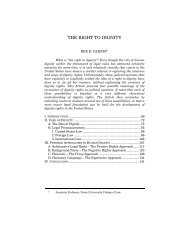A Right to Media? Lorie M. Graham - Columbia Law School
A Right to Media? Lorie M. Graham - Columbia Law School
A Right to Media? Lorie M. Graham - Columbia Law School
Create successful ePaper yourself
Turn your PDF publications into a flip-book with our unique Google optimized e-Paper software.
2010] A RIGHT TO MEDIA? 493<br />
relevant <strong>to</strong> the <strong>to</strong>pic at hand was the recommendation that media<br />
organizations “encourage the recruitment and advancement of<br />
Aboriginal and non-Englishspeaking journalists within the industry”<br />
and train non-indigenous journalists <strong>to</strong> be more culturally sensitive<br />
in their reporting. 254<br />
Australia has taken a number of important steps <strong>to</strong> meet its<br />
duties under Article 16 of the UNDRIP <strong>to</strong> promote a right <strong>to</strong> media.<br />
These steps include promoting indigenous run media 255 and<br />
encouraging national efforts, through its public broadcasting<br />
corporation, <strong>to</strong> develop appropriate guidelines in the coverage of<br />
indigenous communities by non–indigenous media. 256 Moreover,<br />
infrastructure projects such as NITV have the potential <strong>to</strong> reach<br />
larger audiences, both indigenous and non-indigenous. 257 Yet, as is<br />
true for many countries with large indigenous populations, Australia<br />
must assume the larger task of promoting <strong>to</strong>lerance and<br />
understanding between indigenous and non-indigenous communities.<br />
4. Maori <strong>Media</strong><br />
The indigenous peoples of New Zealand, the Maori, have for<br />
centuries asserted their rights <strong>to</strong> self-determination through media.<br />
As certain scholars note:<br />
Maori have a his<strong>to</strong>ry of using media <strong>to</strong> preserve cultural<br />
practices and <strong>to</strong> organise resistance <strong>to</strong> colonisation . . . .<br />
Maori quickly realized the need for media production,<br />
developing the first Maori language newspaper in 1842 and<br />
production radio broadcast from 1942. These developments<br />
enabled Maori <strong>to</strong> engage in deliberations regarding<br />
indigenous rights and represent a community-based<br />
tradition of media production . . . . 258<br />
These important linkages were recently affirmed by the<br />
Waitangi Tribunal, an inquiry commission charged with the task of<br />
investigating actions of the Crown dating back <strong>to</strong> the 1840s. 259<br />
254. Id. paras. 59–62.<br />
255. See supra notes 227–238 and accompanying text.<br />
256. See supra note 239 and accompanying text.<br />
257. See supra note 242 and accompanying text.<br />
258. Hodgetts et al., supra note 2, at 193.<br />
259. See Waitangi Tribunal, Report of the Waitangi Tribunal on the Te Reo<br />
Maori Claim, para. 7.2.3 (1989) (“We are quite clear in our view that Article II of<br />
the [Waitangi] Treaty guarantees protection <strong>to</strong> the Maori language as we have<br />
said, and we are also quite clear in our view that the predominance of English in<br />
the media has had an adverse effect upon it.”); Laura Beacroft, The Treaty of















